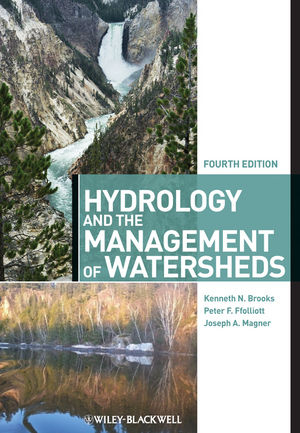
Hydrology and the Management of Watersheds
Wiley-Blackwell (Verlag)
978-0-470-96305-0 (ISBN)
AUTHORS Kenneth N. Brooks is Professor Emeritus of Forest Hydrology in the Department of Forest Resources at the University of Minnesota. Peter F. Ffolliott is Professor Emeritus of Watershed Management in the School of Natural Resources and the Environment at the University of Arizona. Joseph A. Magner is a Research Professor in the Department of Bioproducts and Biosystems Engineering at the University of Minnesota.
Preface xiii
Definition of Terms xv
1 Watersheds, Hydrologic Processes, and Pathways 3
1 Introduction 7
Overview 7
Watersheds 10
Integrated Watershed Management 12
Sustainable Use and Development of Natural Resources 14
Watersheds, Ecosystem Management, and Cumulative Effects 20
Reconciling Watershed and Political Boundaries 21
Summary and Learning Points 24
References 24
Webliography 26
2 Hydrologic Cycle and the Water Budget 27
Introduction 27
Properties of Water 27
The Hydrologic Cycle 30
Energy and the Hydrologic Cycle 38
Water Flow in Soil 43
Water Flow on Land and in Stream Channels 47
Summary and Learning Points 47
References 48
3 Precipitation 49
Introduction 49
Precipitation Process 50
Rainfall 53
Snowfall 63
Summary and Learning Points 78
References 78
Webliography 79
4 Evaporation, Interception, and Transpiration 81
Introduction 81
The Evaporation Process 82
Evaporation from Water Bodies 83
Evaporation from Soil Surfaces 85
Interception 85
Transpiration 92
Potential Evapotranspiration 103
Estimating Actual Evapotranspiration 105
Summary and Learning Points 109
References 110
5 Infiltration, Pathways of Water Flow, and Recharge 113
Introduction 113
Infiltration 113
Pathways of Water Flow 125
Summary and Learning Points 138
References 138
6 Streamflow Measurement and Analysis 141
Introduction 141
Measurement of Streamflow 141
Methods for Estimating Streamflow Characteristics 148
Summary and Learning Points 170
References 171
Webliography 172
7 Groundwater and Groundwater–Surface Water Exchange 173
Introduction 173
Groundwater 174
Groundwater–Surface Water Exchanges 187
Summary and Learning Points 193
References 194
Webliography 195
2 Physical, Chemical, and Biological Linkages of Water Flow 197
8 Soil Erosion Processes and Control 199
Introduction 199
Surface Soil Erosion 199
Erosion from Gullies and Ravines 221
Soil Mass Movement 230
Summary and Learning Points 237
References 238
Webliography 241
9 Sediment Supply, Transport, and Yield 243
Introduction 243
Sediment Supply and Transport 244
Measurement of Sediment 255
Sediment Yield 258
Cumulative Watershed Effects on Sediment Yield 260
Summary and Learning Points 263
References 264
10 Fluvial Processes and Implications for Stream Management 267
Introduction 267
Fluvial Geomorphology 268
Valley and Stream Evaluation and Classification 272
Stream Classification 285
Summary and Learning Points 293
References 293
Webliography 295
11 Water-Quality Characteristics 297
Introduction 297
Chemistry of Precipitation 298
Physical Characteristics of Surface Water 300
Dissolved Chemical Constituents 311
Biological Characteristics 319
Groundwater Quality 323
Cumulative Effects 324
Summary and Learning Points 325
References 326
Webliography 328
3 Integrated Watershed Management 329
12 Managing Wildland Watersheds 333
Introduction 333
Forests 333
Woodlands 364
Rangelands 367
Upland–Downstream Considerations 371
Cumulative Watershed Effects 377
Summary and Learning Points 379
References 380
Webliography 387
13 Managing Riparian Communities and Wetlands 389
Introduction 389
Riparian Communities 389
Wetlands 401
Cumulative Effects 422
Summary and Learning Points 422
References 423
14 Watershed Management Issues 427
Introduction 427
Fragmentation of Watershed Landscapes 427
Water Harvesting 439
Best Management Practices 442
Regulatory Compliance 446
Climatic Variability 451
Insufficient Information for Decision Making 455
Summary and Learning Points 456
References 458
Webliography 461
15 Socioeconomic Considerations in Integrated Watershed Management 463
Introduction 463
Policies and Policy Processes 464
Planning and Implementation 470
Economic Appraisals 475
Summary and Learning Points 486
References 487
16 Tools and Emerging Technologies 489
Introduction 489
Generalized Hydrologic Simulation Models 490
Technologically Advanced Tools 495
Using the Stable Isotopes of Hydrogen and Oxygen 500
Summary and Learning Points 507
References 508
Webliography 511
Appendix: Units Commonly Used in Hydrologic Work, USA 513
Index 517
Color plates appear between pages 512 and 513
| Erscheint lt. Verlag | 14.12.2012 |
|---|---|
| Verlagsort | Hoboken |
| Sprache | englisch |
| Maße | 178 x 249 mm |
| Gewicht | 1111 g |
| Themenwelt | Naturwissenschaften ► Geowissenschaften ► Hydrologie / Ozeanografie |
| Technik ► Bauwesen | |
| Weitere Fachgebiete ► Land- / Forstwirtschaft / Fischerei | |
| ISBN-10 | 0-470-96305-0 / 0470963050 |
| ISBN-13 | 978-0-470-96305-0 / 9780470963050 |
| Zustand | Neuware |
| Informationen gemäß Produktsicherheitsverordnung (GPSR) | |
| Haben Sie eine Frage zum Produkt? |
aus dem Bereich


